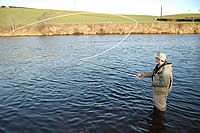The Circle Spey or Circle "C" as it is sometimes called can be used as an alternative cast to the single Spey cast as it is another cast that is much safer and much more efficient when used in an upstream wind. It is also a cast that can assist you with your anchor placement if having difficulty with the single Spey. Here are a few uses for the Circle "C" cast.
-
A very good cast for consistent anchor placement.
-
Can be used to good effect when making a variety of angle changes.
-
It can be very useful to raise a sunk line to the surface.
-
It can also dig out a heavy fly prior to casting.
-
It can assist placement of D loop between gaps in the bank foliage as it allows you to slow down the pace of it's set up.
-
It can be used when fishing heavy bugs for Grayling etc to ping your flies upstream when requiring more depth.
- It's a great cast when using droppers (e.g. spider fishing) as tangles can become a thing of the past.
|
When executing this cast with the double hander from the right bank, with left hand uppermost, (see single Spey) imagine you are drawing a large capital C prior to forming your D loop and delivering the cast, you will then realise why it is called a circle "C" cast. Although when fishing from the left bank, (see single Spey) you will actually be drawing an inverted  and have your right hand uppermost. Either way the C is quite significant when trying to remember this cast. and have your right hand uppermost. Either way the C is quite significant when trying to remember this cast.
The circle C cast can also be a very effective cast with the single handed rod (as seen in the picture below) especially if you are using a team of flies such as spiders for instance, as the circular movement will lay them out in line on the water above you prior to the delivery of the cast, limiting the chances of your flies becoming tangled on the forward cast, as they might during a Single Spey or an overhead cast.
Always remember that the rod tip must be returned to it's downstream position (just above the water surface) immediately after the "C" shape has been formed. This will afford you a long smooth upstream climbing sweep which you will need to create your D loop prior to the delivery of the cast. downstream position (just above the water surface) immediately after the "C" shape has been formed. This will afford you a long smooth upstream climbing sweep which you will need to create your D loop prior to the delivery of the cast.
Finally it must be pointed out that this cast, as apposed to the Snap "T" cast, is a much safer cast when using heavy flies (e.g. brass tubes, or heavy bugs) as it allows you to keep these flies well away from the rod tip during it's more open initial circular movement.
For further information on the Circle "C" and Snap T casts you can view a more in depth article in a PDF document on the following link Click here. This article can also be accessed from the bottom of the Home Page under the heading of Six of the Best Spey Casts.
< Back
|
